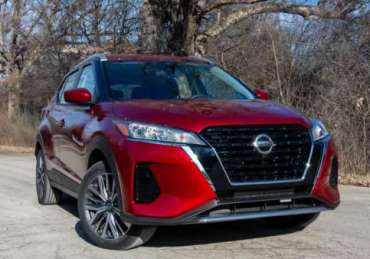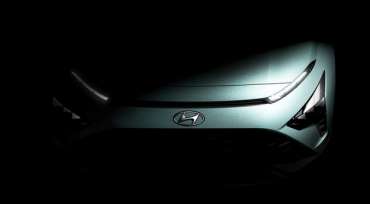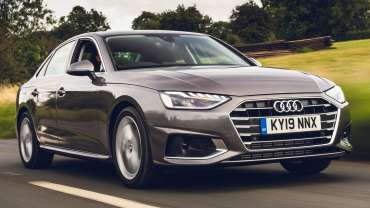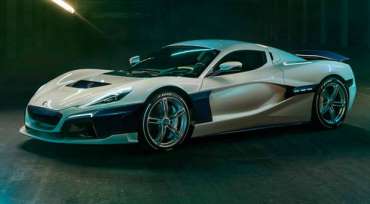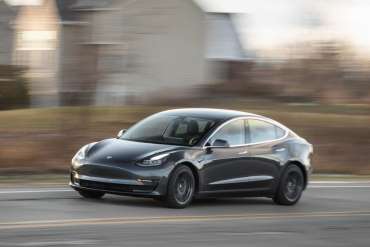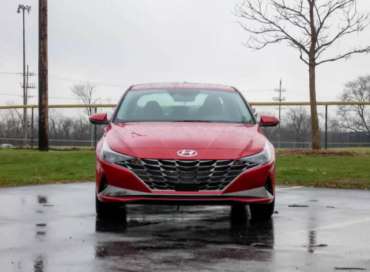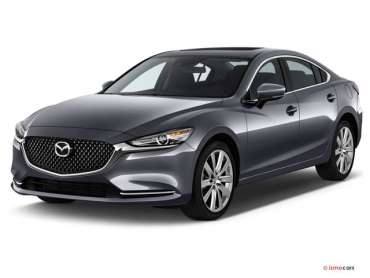
Worldcarblog.com
2021 Nissan Kicks Review: Same Value, More Friendly
Still cheap, still cheerful, the 2021 Nissan Kicks keeps its tech current while adding some customizable flair.
Versus the competition: With its solid combination of safety equipment, multimedia tech, versatile interior space and value pricing, the Kicks holds its own against competitors like the Hyundai Venue, Kia Soul and other front-wheel-drive-only tiny SUVs. That lack of all-wheel drive keeps it from being fully competitive against models like the Ford EcoSport, Hyundai Kona and Honda HR-V.
The cheap and cheerful end of the SUV showroom is getting a lot of attention from automakers as buyers continue to eschew subcompact hatchbacks and sedans in favor of the slightly larger, slightly taller SUV-style models. Tall crossovers like the Nissan Kicks, Hyundai Venue and Honda HR-V are replacing the Nissan Versa, Hyundai Accent and Honda Fit in the eyes of consumers as the more desirable entry-level models. They’re more expensive than their sedan counterparts, but that hasn’t stopped buyers from making them their choice. In order to keep the Nissan Kicks competitive in the wake of a growing field of competitors, the brand has released a slightly refreshed version for 2021 with some subtle changes inside and out that it hopes will keep the diminutive runabout fresh.
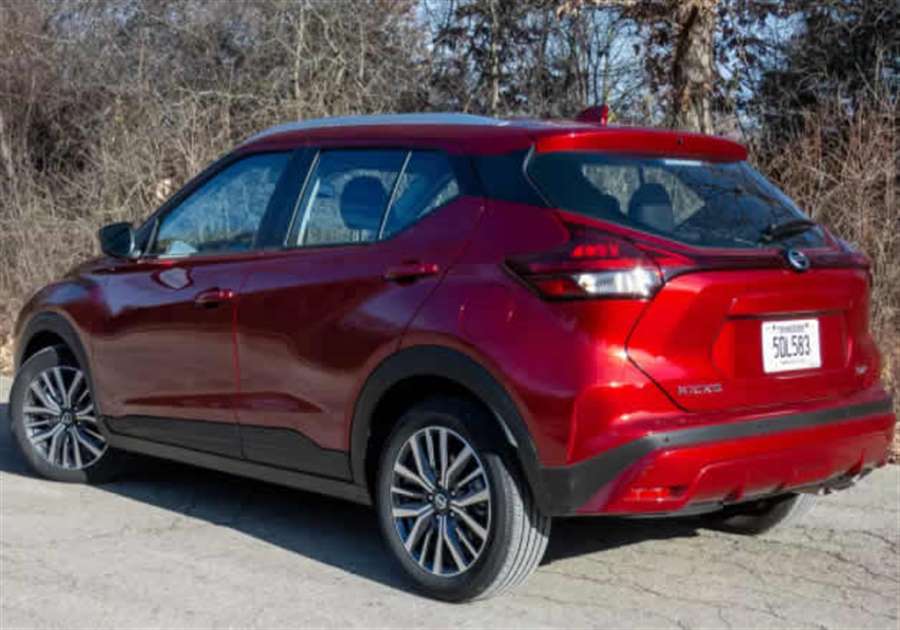
Looks a Little Sharper
Nissan has done a good job updating the look of the Kicks to more closely fit in with the rest of the redone Nissan showroom, all of which is getting a redo as part of the global Nissan Next product update plan. There’s a new grille, headlights, foglights, bumper and trim up front, and revised taillights and trim out back. The look is a very slight change, but it does modernize the Kicks a bit more, and it helps to draw the eye to a wider look even though the car’s track measurements haven’t changed at all. There are also some new wheels available, which are themselves customizable.
2020 Nissan Kicks Specs & Reviews Find a 2020 Nissan Kicks Near You
Nissan is introducing a new program that will allow Kicks buyers to personalize their rides through the Kicks Color Studio, which will offer more than a dozen colored elements — including wheel caps and inserts, mirrors, interior vents and more — that can be mixed and matched in ways to suit the buyer’s tastes. We haven’t yet seen what might be accomplished through use of the Color Studio, but the car itself does benefit from all of the styling changes that have been made. It sports the now-ubiquitous, optional, two-tone floating roof treatment that nearly all SUVs seem to have adopted, but its edgy styling does differentiate it from more generic boxes like the Hyundai Venue and Ford EcoSport. The difference between the 2020 and 2021 model Kicks is subtle, and you’d likely have to park one next to the other to spot the changes, but the new aesthetic is more attractive than the outgoing one.
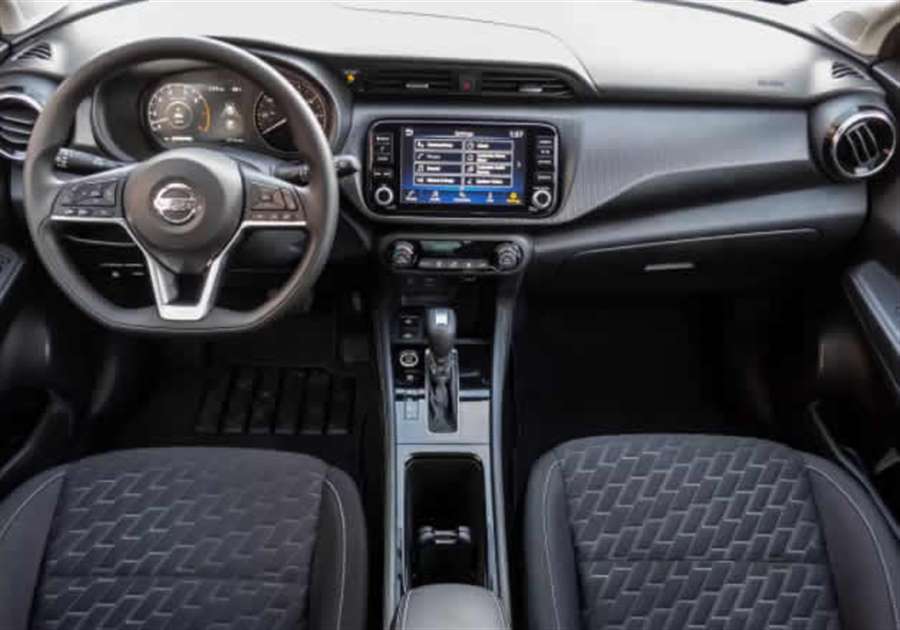
Hope You Aren’t in a Hurry
Powering the Kicks is a dinky 1.6-liter four-cylinder engine making 122 horsepower and 114 pounds-feet of torque. If that doesn’t sound like a whole lot of grunt, that’s because it’s not. It’s mated to a continuously variable automatic transmission that actually does a decent job of keeping the engine in its limited power band, giving the Kicks the descriptor of “adequately powered, but only just.” Let’s put it this way: In a stoplight drag race between a new Kicks and new 121-hp Hyundai Venue, neither would win. If you want more power, you’ll have to look to a Kia Soul, Honda HR-V or a turbocharged Jeep Renegade. But the lack of any sort of sportiness or alacrity to the drivetrain is OK, as the steering and handling aren’t tuned for entertainment purposes, either. The Kicks rides quite nicely, absorbing bumps and road imperfections with impressive damping, but it’s also a bit floaty, leaning more than you might expect in corners or on highway on-ramps. The steering is highly boosted and not blessed with a quick ratio, but again, this isn’t a ding against the Kicks, as the SUV is basically designed to do one thing well: be cheap, reliable, useful urban transportation.
The benefit of seemingly being powered by a band of lethargic gerbils is fuel economy that tops the list of competitors: 31/36/33 mpg city/highway/combined, unchanged from the 2020 model year. You won’t achieve those levels if you drive it with a heavy foot, but if you’re using the Kicks as it’s intended to be used, these numbers should be achievable. Part of the reason they’re achievable is that the Kicks is available only with front-wheel drive, similar to vehicles like the Hyundai Venue and Kia Soul, and unlike the Honda HR-V, Ford EcoSport and Jeep Renegade that offer optional all-wheel drive.
This really is intended as a city car, one you’d buy if you have limited parking space, fight narrow streets filled with delivery trucks all the time, or need a basic conveyance to get you and friends or cargo around town easily. In that role, the Kicks excels — lower-speed stop-and-go traffic is where it truly feels most at home, with excellent outward visibility, surprisingly good sound insulation and an upright, high-sitting driving position that makes you feel like you’re piloting something other than a dinky little subcompact SUV. It’s not that the Kicks can’t handle the highway — it does so rather well, with a surprising amount of steady high-speed calmness for such a small vehicle. It’s just that the compact dimensions, clever packaging and ease of use lends itself to tighter urban environments instead of America’s wide interstates.
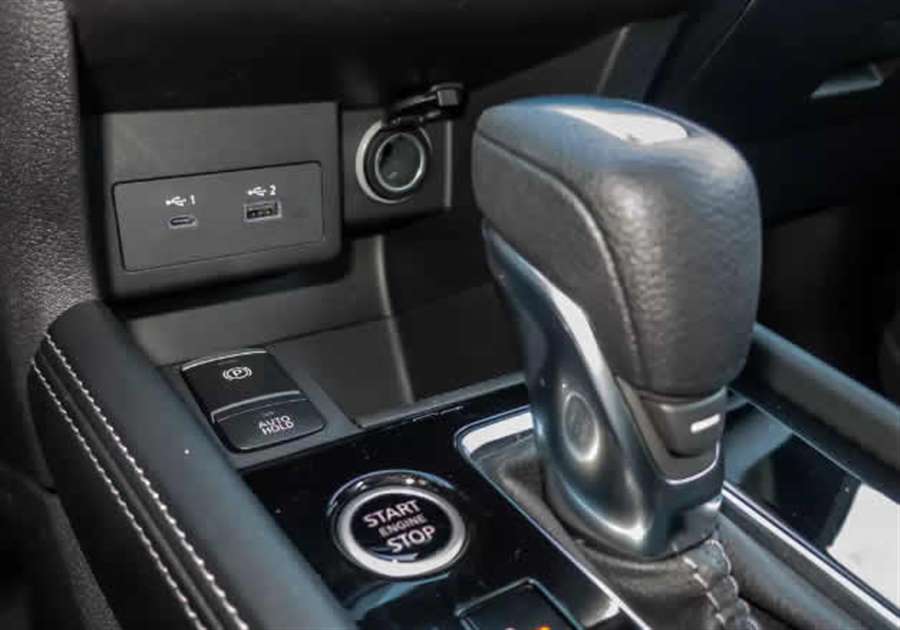
New Tech, Nicer Inside
The interior gets a little love from Nissan in this refresh, as well, but just like the outside, changes are minimal and designed to further improve the experience, not dramatically change it. First and foremost is the new optional 8-inch touchscreen; a 7-inch screen (2020’s only offering) is still standard. The new 8-inch model feels big in this compact interior, and all versions now feature standard Apple CarPlay and Android Auto, another thing that used to be optional. The rest of the interior looks largely the same, with Nissan insisting there are new materials, new vents, new trim and new covering material for the dash and doors. A new center console armrest replaces the previous driver-seat-mounted armrest, but it’s still too small and too low to be of any use for actually resting your arm.
The interior isn’t overly spacious, but it doesn’t feel cramped. The seats sit high but are oddly firm and not terribly comfortable for longer missions. Backseat room is adequate, with decent room for two to sit without their knees pressed against the front seatbacks. It doesn’t feel like it has the bountiful legroom of a Nissan Versa or Sentra, but it’ll do for getting friends to dinner across town or younger kids to soccer practice. The cargo area is surprisingly large, with a deep well and a surprising reach from the liftgate to the rear seatbacks that make for more room back there for luggage or boxes than you might expect to find. Of course, those seatbacks fold to increase the cargo area, but they don’t fold flat; they remain raised above the level of the cargo floor, so the surface isn’t totally flat for larger items.
Research the Nissan Kicks
The cabin is competitive with others in the class thanks to the updated multimedia system, the option of up to four USB ports (two type A, two type C), and its acceptable level of space and utility. The Honda HR-V still feels like it has a more cavernous cargo area, especially with its trick folding backseat stowed, and the Hyundai Venue’s interior feels a bit more upscale, with a multimedia system that simply seems better designed and a level of standard safety systems that hasn’t yet been beaten. But the Kicks feels like an easily viable alternative to any of them, with its subtle improvements keeping it in the hunt for those first-time buyers seeking something new and relatively affordable with all the latest tech, a solid level of standard safety equipment and a value equation that definitely works in its favor. It’s a decidedly competitive entry to the burgeoning field of entry-level vehicles and should be on anyone’s consideration list when shopping for one.
Full pricing for the 2021 Kicks was not yet available at the time of publication, but overall pricing is not expected to be appreciably different from the outgoing 2020 model given its starting price of $20,595 (including destination), a modest $430 increase.
Source: cars.com
Soon and Hyundai Bayon
Hyundai Motor has announced a new announcement of the image of its new crossover Baion. It is coming to the European market in the first half of 2021, which is an important addition to the current line of Hyundai SUVs.
With the launch of the new, additional B-segment model as an entry point into its SUV line, Hyundai sees a great opportunity to better meet the demand of European customers and increase supply in the very popular segment.
The name Baion is inspired by the city of Baion in southwestern France. Since the Hyundai Bayon is primarily a European product, Hyundai decided to name it after a European city. Located between the Atlantic coast and the Pyrenees, the French city is a great location for those who enjoy activities such as sailing and hiking, fitting into the life character of the new model.
More details about the Hyundai Bayon will be revealed soon, but it is expected to use the same platform as the new i20.
Among other things, the offer should include a 1.0-liter three-cylinder turbo gasoline engine with 120 hp.
Customers will be offered a choice between manual and automatic transmissions, and the equipment will also include a digital instrument panel and a 10.25-inch infotainment system screen.
Audi A4 saloon review
"The Audi A4 is a comfortable and economical executive saloon with a stylish, technology-laden interior"
The Audi A4 has been involved in an ongoing battle in the executive saloon class with the BMW 3 Series and Mercedes C-Class for 30 years. Historically, each of this German trio boasted strengths in different areas; the A4 brought an understated design and quattro four-wheel drive, the 3 Series was the driver’s choice, and the C-Class was about sublime comfort and quality. Times have changed, with all three competitors now more equal than ever before, ensuring the latest versions all need to be impressive all-rounders.
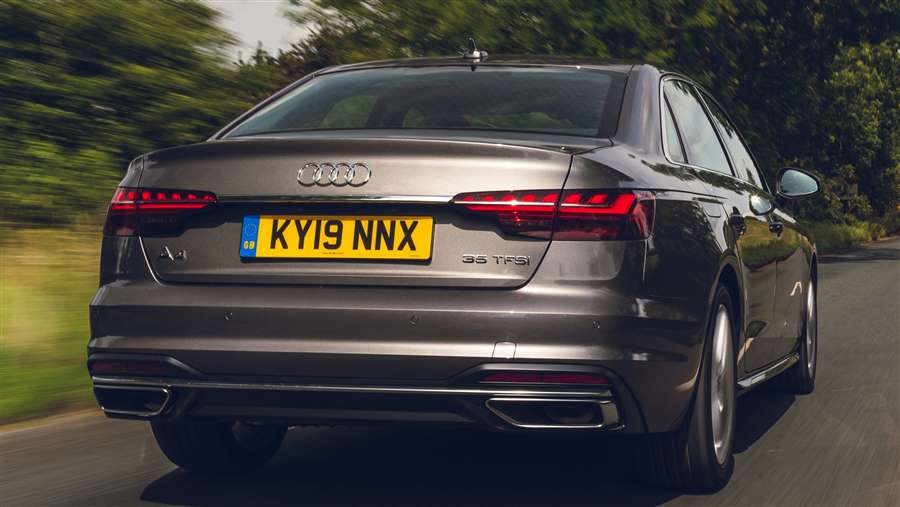
Best executive cars
All three of these executive specials now offer an increasingly similar list of qualities making picking between them more difficult. As well as a direct rivalry with each other, recent years have seen strong offerings from rival manufacturers, with the Alfa Romeo Giulia, Jaguar XE and Lexus IS providing strong competition. This means the Audi A4 can’t afford to rest on its laurels, and the latest model is a spacious, practical and relatively fuel-efficient machine.
A recent significant facelift has seen the A4 evolve again to keep itself in the fight with the new BMW 3 Series and updated Jaguar XE. Its looks have changed quite significantly, with a new nose that's now even more purposeful and striking designs for its front and rear lights. The interior has been given a revamp and mild-hybrid engines ensure lower running costs for company-car drivers.
For enthusiastic drivers, the A4 gets off to a lacklustre start whether you pick a quattro four-wheel drive or a front-wheel drive variant, as it lacks the nimble agility offered by the rear-wheel drive BMW 3 Series. This new model is an improvement over the previous generation, though, with a vastly improved ride quality that is more compliant with the potholed roads of Great Britain, with the optional adaptive suspension allowing you to choose between a soft or firm spring setup. There's no option of air suspension, like in the Mercedes C-Class, though.
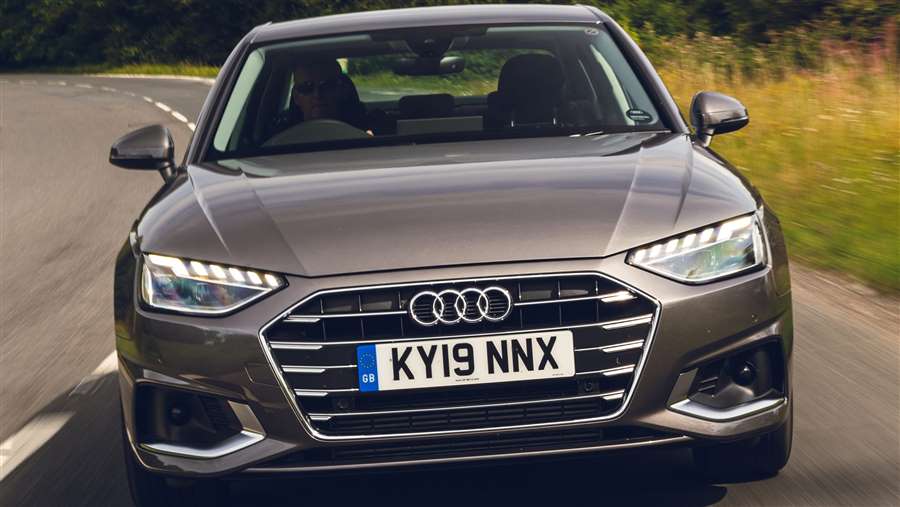
There's a wide range of engines to choose from. Those who cover fewer than 12,000 or so miles a year will be well served by the modern, turbocharged 2.0-litre petrols. Available with either 148bhp, 201bhp or 261bhp, and badged 35, 40 and 45 TFSI respectively, our favourite is the mid-level model, returning up to 40.9mpg despite a swift 0-62mph time of 7.1 seconds.
Those who cover a higher annual mileage might prefer a diesel, and the 161bhp 2.0-litre 35 TDI is a great all-rounder, with up to 58.9mpg claimed, combined with low Benefit-in-Kind (BiK) company-car tax rating. There's also a high-performance Audi S4 saloon, fitted with a 336bhp diesel engine, which we've reviewed separately.
Those who cover a higher annual mileage might prefer a diesel, and the 161bhp 2.0-litre 35 TDI is a great all-rounder, with up to 58.9mpg claimed, combined with low Benefit-in-Kind (BiK) company-car tax rating. There's also a high-performance Audi S4 saloon, fitted with a 336bhp diesel engine, which we've reviewed separately.
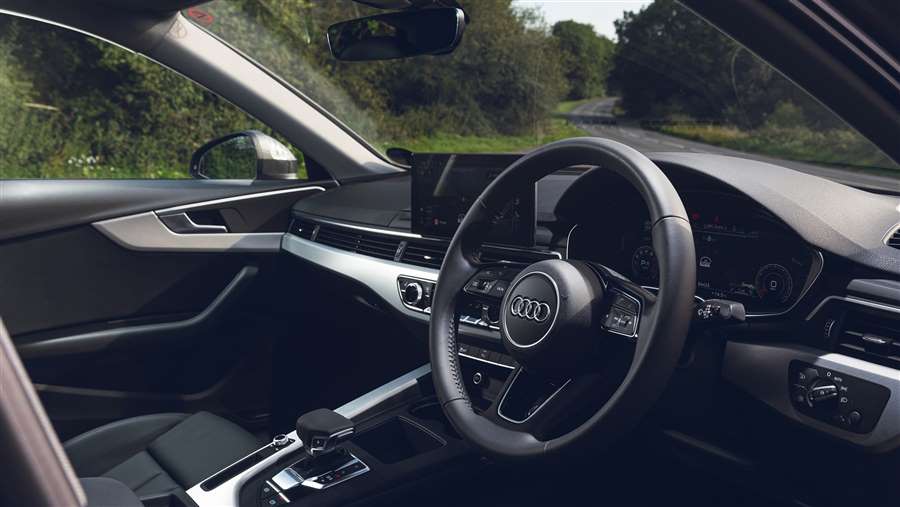
Even the cheapest Technik trim is well equipped, with a 10.1-inch infotainment screen and Audi's Virtual Cockpit fitted as standard. Sport Edition, S line and Black Edition add desirable styling to the mix, while the top Vorsprung grade includes adaptive suspension, LED Matrix headlights, a sunroof and lots of driving assistance kit to make the A4 safer.
The Audi A4 finished 73rd out of the 100 cars ranked in our 2019 Driver Power owner satisfaction survey of cars currently on sale in the UK but didn’t appear in our 2020 list. Euro NCAP awarded the A4 a five-star score in crash-testing.
If you're in the market for a compact executive saloon, then the Audi A4 ticks virtually all the boxes. It's economical, spacious, well built, packed with tech, has a beautifully designed interior and, while rivals such as the BMW 3 Series, Jaguar XE and Alfa Romeo Giulia may be more rewarding to drive, the latest generation A4 is the most competent yet on a twisty road. While there's not a lot to separate most of the models in the A4's class, the Audi is a great all-rounder.
Audi A4 saloon - MPG, running costs & CO2
The greenest Audi A4 model can return over 50mpg
Audi has gone to great lengths to improve the Audi A4's fuel-efficiency figures. It's not as if the old car's CO2 emissions and fuel economy were bad in comparison to rivals – far from it – but Audi has to keep cars like the refreshed BMW 3 Series and hi-tech Jaguar XE at bay in order for the A4 to remain competitive.
Company-car drivers are likely to be unimpressed that there's no plug-in hybrid version of the A4. There are some strong rivals here, including the BMW 330e and Mercedes C 300 e that offer low BiK bands thanks to their low CO2 emissions.
Audi A4 MPG & CO2
Like many compact executive cars, the Audi A4 has a huge range of engines to choose from and mild-hybrid technology has been rolled out to boost fuel-efficiency and help cut CO2 emissions. It works by capturing energy while the car is slowing down and using it to power the car's electrical systems. The most economical engine in the range is the 2.0-litre diesel; the 134bhp ‘30 TDI’ is able to return up to 60.1mpg according to Audi. Even the 161bhp ‘35 TDI’ is capable of up to 58.9mpg in trims with smaller wheels. The A4 now has a reduced engine range to choose from, but all are relatively frugal. The more economical diesels are best for high-mileage driver, but relatively high BiK bands mean the petrol models are often now more appealing for company-car drivers.
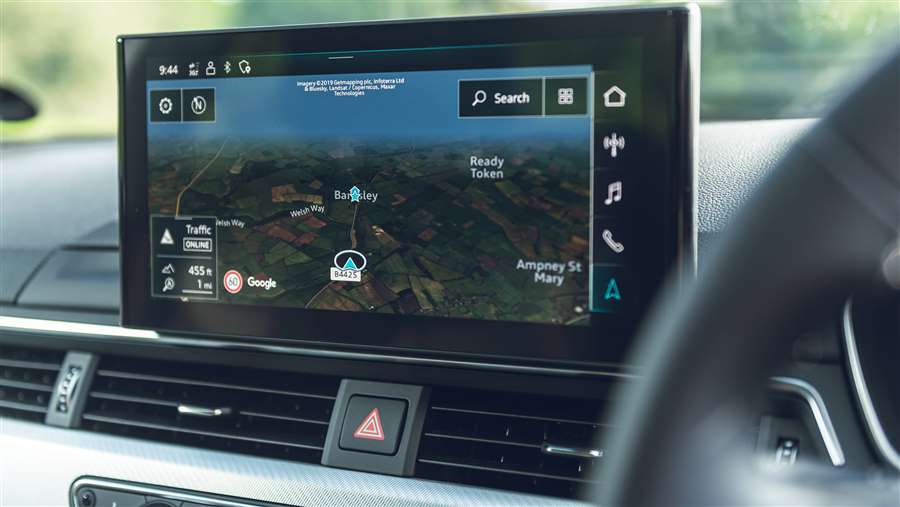
A more powerful, 201bhp version of the 2.0-litre diesel engine is also available with standard quattro all-wheel drive. Badged 40 TDI, it promises fuel economy of up to 54.3mpg. Other engine highlights include a 2.0-litre 35 TFSI petrol with 148bhp, which is capable of up to 46.3mpg and is the least expensive engine in the range to buy.
There are further petrol choices, as you can order an A4 with either 201bhp or 261bhp. While these are very smooth, they're best for low-mileage drivers as fuel economy is up to 44.8mpg and 35.3mpg respectively. They're also only available with more expensive trim levels.
After the first year's CO2-based road tax (generally included in the on-the-road price), all Audi A4s cost £150 a year to tax. Those with a list price (including options) of more than £40,000 are liable for an additional surcharge of £325 a year in years two to six, bringing the annual bill to £475 during that period.
Insurance
The entry-level petrol 35 TFSI sits in group 23, while the 40 TFSI in Sport trim climbs to group 29. The 30 TDI starts from group 22 out of 50, while the range-topping diesel S line 40 TDI quattro is in group 30.
Warranty
Audi's warranty looks a little stingy in the face of its competition; its three-year/60,000-mile cover is pretty standard fare, with BMW and Mercedes providing unlimited-mileage cover over the same time period. The standard warranty can be extended to four years/75,000 miles for around £400 or five years/90,000 miles for just under £1,000.
Servicing
Audi offers fixed service intervals of 9,000 miles or once a year, or flexible servicing that can see drivers cover up to every 19,000 miles or two years for the major between services. Flexible servicing is recommended for drivers with a high annual mileage, while fixed servicing better suits town and city drivers making frequent, short trips. Audi offers owners a range of fixed-price service deals.
Audi A4 saloon - Engines, drive & performance
The Audi A4's handling and performance has been much improved over its predecessor
One of the biggest complaints about the old Audi A4 was its rather numb steering. That car didn't exactly feel great to drive, which was why we recommended the BMW 3 Series or Jaguar XE for more enthusiastic drivers.
The latest generation is a big improvement in that regard – the steering is sharper and offers more feel and feedback, but it's still very light.
Although Audi has made the A4's suspension slightly softer and more comfortable than before, there's very little body lean, so you won't get thrown about inside if you go around a roundabout too enthusiastically. It’s still not the outright driver’s choice, though – the A4 feels a bit characterless next to rivals like the BMW 3 Series, Alfa Romeo Giulia and Jaguar XE.
Selecting the optional adaptive suspension system's Comfort mode improves the ride quality further, although whether it's worth spending the extra cash on depends on how much you value a soft ride. We’d recommend the upgrade, as the standard car is noticeably firmer than many of its rivals, especially over rougher roads. S Line trim versions are firmer again, with sports suspension that lowers the car by 23mm.
As always, Audi offers its ‘quattro’ four-wheel-drive setup on some models in the A4 range. This ensures there's always enough traction, which could be useful in rain-soaked Britain, but the standard front-wheel-drive version should be more than competent enough for most buyers.
You can choose between a six-speed manual transmission, a seven-speed S tronic dual-clutch automatic gearbox with steering column-mounted shift paddles – or a more conventional eight-speed automatic with the more powerful engines. The S tronic is a particularly good gearbox, offering quick shifts in manual mode and smooth changes in auto mode. It's the only option for most of the range, as the 35 TFSI is the only engine where the manual gearbox is offered.
Audi A4 petrol engines
The Audi A4 petrol range has simplified and been thoroughly worked over. A 148bhp 2.0-litre turbocharged engine called 35 TFSI kicks off the range, joined by two higher-powered versions of the same engine - producing either 187bhp or 242bhp, and badged 40 TFSI and 45 TFSI.
All three engines are very smooth and remarkably quiet on the move and the 40 and 45 TFSI feel fairly potent. Audi predicts the 35 TFSI will be the strongest seller in the range, and it has just enough performance to suit the car, without being hugely thrilling on a fun road.
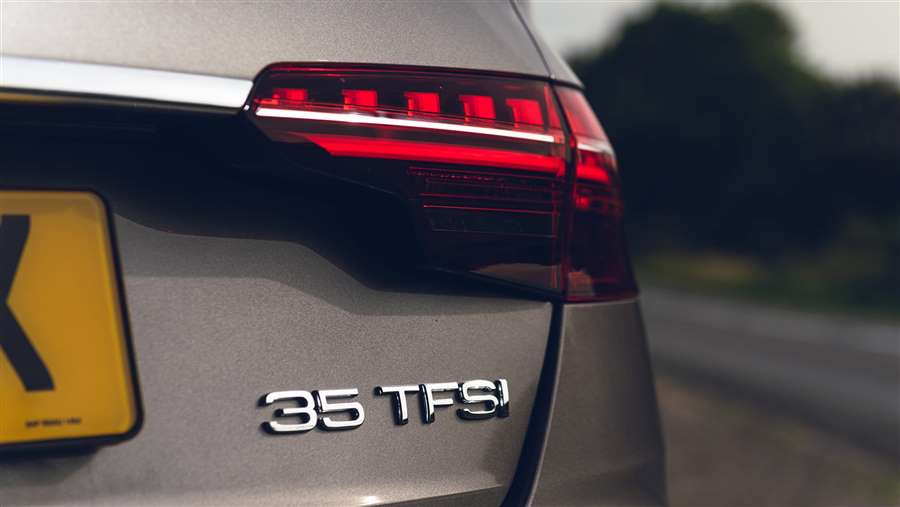
Diesel engines
Three diesel options are now available, all with a capacity of 2.0 litres and fitted with an S tronic dual-clutch automatic gearbox. With either 134bhp, 161bhp or 201bhp, the 2.0-litre engines are badged 30, 35 and 40 TDI respectively and should be powerful enough for most drivers. They boast a smooth power delivery and are quieter than the diesels fitted to the previous A4. For many drivers, the 35 TDI is likely to be the pick of the bunch, offering reassuring performance when overtaking or driving on the motorway. It gets from 0-62mph in 8.2 seconds with front-wheel drive - quattro is only available for the 40 TDI, where it's fitted as standard.
Audi A4 saloon - Interior & comfort
The Audi A4's interior is impeccably built and there's loads of technology on board
The Audi A4's interior is awash with gadgets and technology, featuring equipment and design ideas from other recently revised Audi models like the Audi TT coupe, Audi R8 supercar and Audi Q7 SUV.
The 2019 facelift means the A4 has even more of this technology as standard, with analogue gauges now a thing of the past. Not every move is positive; the touchscreen-only infotainment system isn't as easy to use while driving as the old control wheel.
Audi A4 dashboard
Audi has removed as much clutter from the dashboard as possible in recent years, with the A4 featuring a minimalist layout inside. It also has an incredibly well built interior that just oozes class and sophistication. It's still a more sober design layout you get in the rather flashy Mercedes C-Class, but Audi's penchant for creating classy interiors has been maintained in the A4.
The 'Virtual Cockpit' instrument cluster has been updated and now comes as standard - and it's the best in the business for clarity and ease of use, with all the controls at your fingertips on the steering wheel. The only buttons that remain on the dashboard operate the climate control and essential features. The automatic versions have an aircraft-throttle-like gearlever, which looks smart and doubles as a wrist-rest.
The central vent that's fixed into the dashboard is called an 'air shower'. It's meant to diffuse air gently towards occupants, rather than simply blowing it in your face like traditional air vents.
Audi’s 10.1-inch infotainment system comes as standard, with high-definition graphics and touchscreen operation. After many years, Audi has decided to drop the wheel selector in the centre console, but this feels like a backwards step when driving as it can be tricky to prod the screen on the move. Instead, it's better to use voice commands once on the move.
The built-in sat nav system uses Google Maps and loads with lightning speed, which is partially due to a super-fast processor that gives the most technically advanced computers a run for their money. Overall, it's not quite as user-friendly as the latest BMW iDrive system, but it comes very close.
Equipment
Trim levels are called Technik, Sport Edition, S line, Black Edition and Vorsprung, and even the entry-level version is well appointed. There are 17-inch alloy wheels, LED headlights, heated front seats, three-zone climate control, sat nav, DAB radio and a rear-view camera.
Sport Edition adds bigger wheels and some extra style, which is improved upon again by S line. S line also drops the suspension by 23mm, so be aware it won't ride quite as smoothly - an issue exacerbated by 19-inch wheels. Tinted glass is also added, along with sports seats embossed with the 'S' logo and trimmed in leather and Alcantara.
Based on S line, Black Edition replaces exterior chrome with black trim for a stealthy look. while Vorsprung adds features such as adaptive sport suspension, Matrix LED headlights, a sunroof, driving assistance features and a head-up display.
Options
Options include adaptive cruise control, adaptive dampers, LED 'Matrix' headlights, styling packs and a huge range of accessories. However, they are pricey. A Comfort and Sound Pack bundles features such as keyless entry and a powered boot, a Bang & Olufsen stereo, 360-degree camera view and extended LED lighting around the interior.
Technology
The current A4 is the most advanced yet when it comes to technology. Everything is controlled on a slick touchscreen that sits above the air vents. You can also control various functions through the 'Virtual Cockpit' screen that takes the place of traditional dials in the instrument cluster. It's a 12.3-inch screen that comes as standard and allows you to view maps, media functions and other things like the trip computer in place of the analogue dials of older models.
It's an incredibly slick system and, in combination with the bright central screen, makes using the A4 very easy. A colour head-up display also comes fitted to the Vorsprung trim, which appears to hover in the windscreen, making it easier to check your speed and navigation instructions without being distracted from the road ahead.
There are various USB ports, SD card slots and auxiliary inputs, so you can listen to music in a variety of ways, as well as over Bluetooth, which is very quick to pair with your phone. The A4 can also come with Audi Connect, which allows you to download apps that can show you the weather forecast, petrol prices and even your Twitter feed, plus the car can act as a wi-fi hotspot for up to eight devices.
The A4 also comes with Apple CarPlay and Android Auto, and the switch to a touchscreen makes these interfaces more natural to use than with the old MMI controller.
A large number of A4s serve as company cars, so a responsive and intuitive sat-nav system is a must. Luckily, the A4's system, as with other VW Group systems, is very easy to use and provides clear, easy-to-follow instructions. You can do multi-route planning as well as using the comprehensive point-of-interest search, which also has access to the internet. This gives you contact details for the destination as well as some information from Wikipedia, which is quite useful.
Audi A4 saloon - Practicality & boot space
Boot space is the same as the previous model, but there’s much more interior space in the Audi A4
The Audi A4's interior space is much improved over the previous model, while boot space remains the same. The way the car has been designed means passengers in the front and back now have more room than ever.
Audi A4 interior space & storage
Since the A4 is wider and longer than before, passengers have more room than ever. The rear seats boast 23mm more legroom, which may not sound like much, but it means that people over six feet tall can now sit comfortably in the back. Headroom is impressive, too – much more generous than you'll find in the Jaguar XE. There's also the usual pair of ISOFIX mounting points for child seats.
There's loads of adjustment in both the steering wheel and front seats, so you should find it easy to get into position quickly. There are also some big door bins that can swallow large bottles, but the glovebox and central armrest spaces aren't particularly generous.
Boot space
The A4’s 480-litre boot is identical in size to the BMW 3 Series’ and Mercedes C-Class’. Unsurprisingly for a saloon car, getting larger items into the A4 could be easier, but unlike the C-Class and the 3 Series, the A4 gets folding rear seats as standard.
Stowing them expands the boot volume immensely, and the Audi's seats fold forwards in a versatile 40:20:40 configuration. Like many cars in this class, they don't lie completely flat when dropped, though.
Audi A4 saloon - Reliability & safety
The Audi A4 is safe and modern, but it hasn't all been plain sailing for owners
Audi's famed interiors continue to impress buyers, but issues with flexibility, reliability, running costs and the ride and handling lower its overall score in our Driver Power survey.
Audi A4 reliability
The Audi A4 was rated poorly for reliability in our 2019 Driver Power owner satisfaction survey of cars currently on sale in the UK. Of the owners who responded, 21.0% reported experiencing a problem with their car at least once. The car didn’t appear in our list of the top 75 cars in 2020.
Exterior fit and finish was cited as the most likely problem and while the A4 scored well for its interior, infotainment, comfort and engines, low scores for running costs suggest owners struggle to achieve the official consumption figures and face high maintenance costs. Hopefully the addition of mild-hybrid technology will help the facelifted version meet expectations in this regard.
Audi as a brand finished a fairly disappointing 21st out of the 30 manufacturers rated in 2020, although this is above BMW and Mercedes. Owners praised the build quality of the company's cars but ownership costs and a lowly reliability ranking were less impressive.
Safety
One of the A4's strong points is a range of advanced technology to help keep you safe while driving. The car's adaptive cruise control is so clever that the A4 can almost drive itself in stop-start traffic. The car will also keep itself in lane on the motorway, as long as you periodically place your hands on the steering wheel. Also available on higher-spec cars are Audi's 'Matrix' LED headlights, which dim automatically when on full beam to avoid dazzling the drivers of oncoming cars.
All of this equipment contributed to the A4 getting the full five-star safety rating from independent testing body Euro NCAP, including a 90% score for adult occupant protection, 87% for child protection and 75% for pedestrian protection.
Source: carbuyer.co.uk
Rimac C_Two will soon start mass production
Rimac Automobili announces that it will soon begin mass production of their C_Two model. The pessary phase of production began in December.
"I walk here and see how after 10 years of blood, sweat and tears, all this is coming together - what a feeling. Pre-series production is growing and we are preparing to produce cars for customers. Hats off to the people who made this happen. All their signatures will be on to every customer's car - both figuratively and literally, "Rimac wrote on Facebook.
"We are looking to the future. We started production of pre-production vehicles in December, and now we are progressing towards serial production of C_Two. Pre-production cars will be used for further minor adjustments, homologation and durability tests, trim experimentation, NVH adjustment and global rating We have an important year ahead of us. We appreciate your support at every step, "Rimac Automobil announced at the beginning of the year.
Mate Rimac himself wrote on Facebook that, if everything goes according to plan, he will produce numerous cars in this line in 2021.
Assembling each C_Two car will take approximately five weeks, halving production time compared to the principle of static off-line production, used by some other supercar manufacturers. The new process will enable the construction of four final production vehicles per month at full capacity.
However, in Rimac, the production process begins much earlier before assembling the finished components on the line, since a large number of components and systems are produced in the factory in Sveta Nedelja and Veliki Trgovišće, after which it is delivered to the vehicle assembly line.
The complete homologation procedure without any shortcuts, from the first concepts, through complete prototypes to cars on the road, is a three-year process. With the introduction of the new production line, Rimac Automobili will deliver the first cars to customers in 2021, unlike the original plan before the covid-19 crisis, which foresaw deliveries in 2020. The final design and name of the car will be revealed this year.
Our 2019 Tesla Model 3 Has Logged 19K Nearly Trouble-Free Miles
But we're still waiting for Tesla's Full Self-Driving feature to materialize.
20,000-Mile Update
With more than a year and 24,000 miles logged with our Tesla Model 3, we're way past the honeymoon phase. Our initial 12 months of included premium connectivity has expired, which means in-car audio and video streaming now only works with a Wi-Fi connection. And since not one of our area Superchargers has it, we are no longer whiling away the time spent charging our car by streaming Netflix.
Our maintenance costs thus far have totaled $313, which is on par with the cost for many gas-powered vehicles. That includes two rather steep charges from Tesla's in-house service network: $103 for a tire rotation and $210 for an unusual service to lubricate our car's brake calipers, which is called for annually on cars that reside in a state like ours that uses salt to rid the roads of ice during winter months. That service is to prevent the brakes from seizing, as they don't get much use when regenerative braking from the electric motors is employed more often to slow the car than the conventional friction brakes. Also unusual, though not expensive, is that the key fob has already burned through a battery. We also spent $1088 to replace a cracked windshield, but that was our fault.
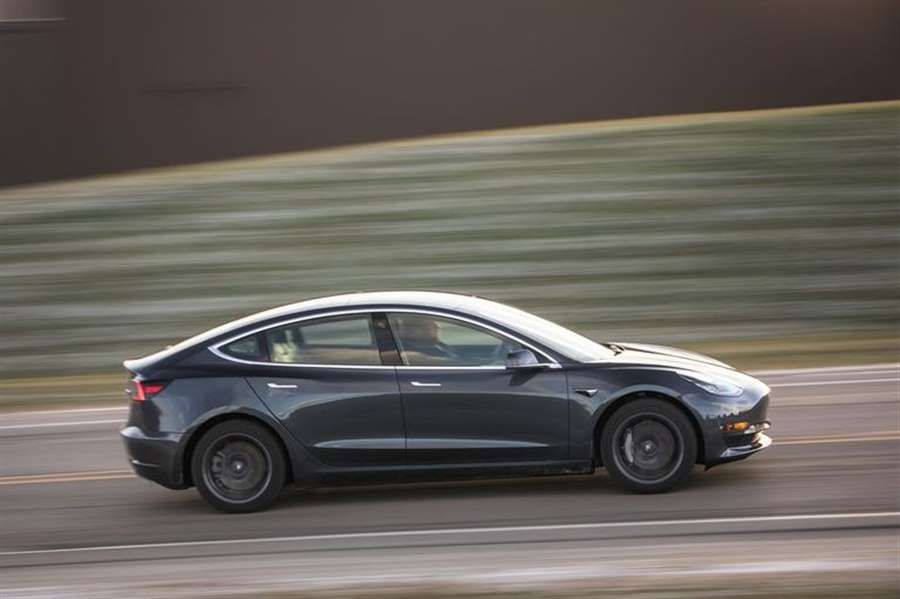
What never gets old, however, is plugging in while out running errands and getting fuel for free. Even 14 months in, that perk still feels novel. We haven't had any other significant issues with our car since the replacement of the rear motor assembly that happened a year ago. The trim on the driver's side B-pillar—the piece you tend to bump getting in and out of the seat—came loose and was fixed under warranty. We noted squeaks and rattles that materialized early on, but those don't seem to have worsened with the additional time and miles.
The spring and summer months substantially improved the Model 3's energy consumption. In the most efficient month, June, we averaged 267 watt-hours per mile (Wh/mile), while in December—with winter tires installed and the average temperature plummeting to 34 degrees compared with June's 81—it increased to 354 Wh/mile. That equates to a 60-mile swing (or 20 percent) in expected range, depending largely on the outside temperature. And that's if it's plugged in overnight. Otherwise, the Model 3 can easily shed an additional 10 or 20 miles of range. Our overall average consumption is 316 Wh/mile, and our average efficiency—unlike consumption, which includes charging losses—has bumped up by 10 MPGe to 84 MPGe.
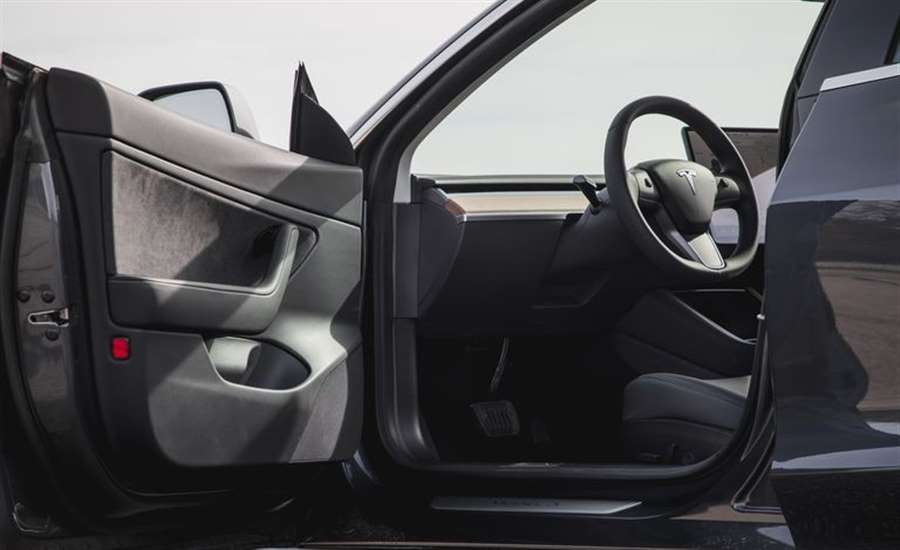
At the current national average residential electricity rate of 13.6 cents per kWh, it's costing us 5.5 cents per mile to power our Model 3. If we instead relied entirely on Tesla's Supercharger network, the cost would nearly double, to 10.4 cents/mile, almost matching the price of keeping our long-term BMW M340i filled with 93-octane premium (10.7 cents/mile). That may be an extreme example, but it proves the point that having a high-voltage charger at home or at your office is critical if you want to reap the potential financial benefits of going electric.
Although our Model 3 was dispatched to our annual Lightning Lap event at Virginia International Raceway, completing each 635-mile leg of that trip from Ann Arbor and back with three stops to charge, we have still yet to beat our previous best of 221 miles between plugging in. That's partially because, according to the TeslaFi tracking tool we're using, our battery has lost 7 percent of its capacity, or 22 miles, since it was new.
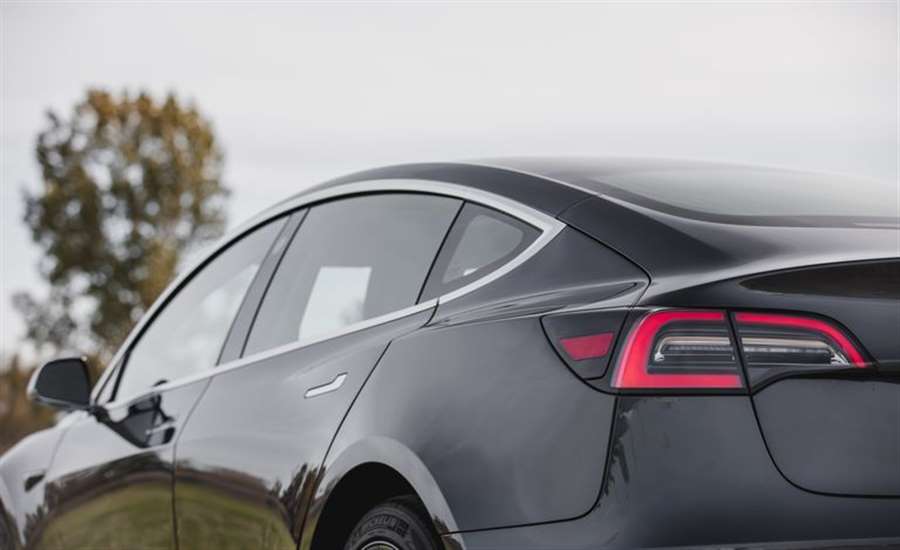
We're still smitten with the Model 3's swiftness. And we're intermittently impressed and befuddled by the varying experiences of its Autopilot feature. Sometimes it seems that fully autonomous driving is nearly upon us. At other times the system bobbles a seemingly straightforward maneuver so badly that we think the promised Full Self-Driving (FSD) capability that we paid for more than a year ago—and are still waiting to materialize—is much further off than Tesla would have the world believe.
Instead of meeting its self-imposed 2020 deadline to release FSD, Tesla deployed a new feature at the tail end of last year, called Boombox, with which we can now assault the outside world with music or various noises—including, naturally, a whoopee cushion—using the car's external speaker. That update also rejiggered the layout of the central touchscreen, giving more real estate to the area that depicts the car's surroundings, which will likely become more important when hands are no longer on the wheel. Both of these are changes that we haven't seen in any other car, proving yet again that the Tesla experience is definitely not car-making as usual, for better and for worse.
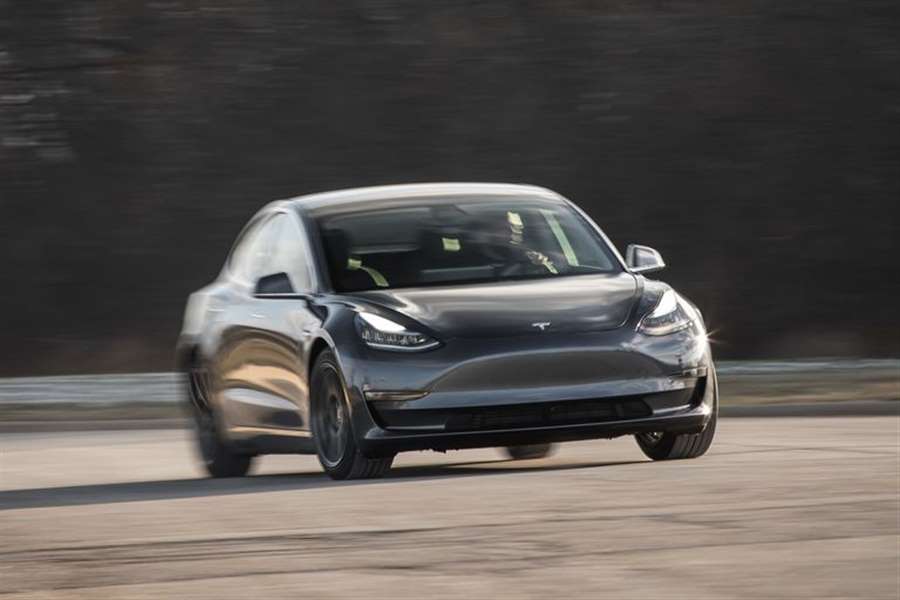
10,000-Mile Update
The updates on many of our long-term cars, particularly the trouble-free ones, tend to be as much about us as about the vehicles. In the absence of reliability or service drama, the focus instead becomes the places we visit, plus whatever new annoyances we find over the course of 40,000 miles.
But the Tesla ownership experience is as different as the driving experience. A Tesla actually changes over time with the company's steady stream of software updates. In the six months and 10,000 miles since we've taken delivery of our Model 3 Long Range, there have been 12 software updates, or an average of one every 16 days. Not all of them are substantial, however; many are small, follow-on updates to fix issues after a major update is released.
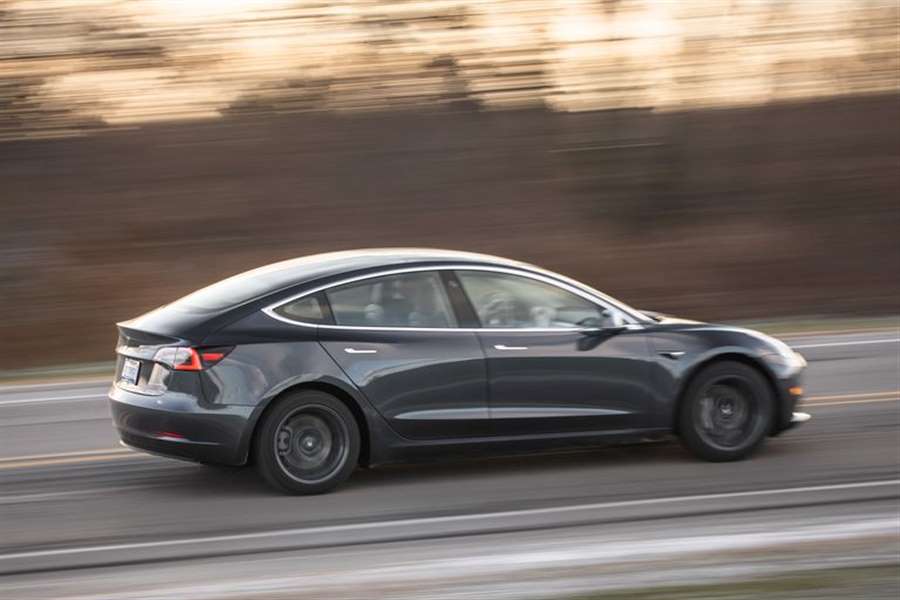
We already mentioned that the update to version 10, a major one, was ready when our car first arrived, and it added Smart Summon and Theater mode, which allows streaming of Netflix, YouTube, and Hulu. It's a great way to pass the time while charging. Since then, we've seen a flurry of changes, such as the addition of true one-pedal driving. (Before the update, the car would slow to about 3 mph but wouldn't come to a complete stop.) There's also Dog mode for maintaining a comfortable cabin temperature while us humans are running errands (and displaying a large message to assuage any window-smashing would-be do-gooders passing by). Dashcam and Sentry mode security features also have been added. Sentry mode stores clips from the array of exterior cameras, either at the driver's behest or when the car detects motion while parked. Just this week, Tesla righted a wrong by adding the ability to view that footage on the car's center screen.
Although the Model 3's acceleration—and particularly its responsiveness—was already garnering universal praise by our staff, one of the updates included a claimed five-percent power bump, which improved our car's performance across the board, including a 0.1-second improvement of its zero-to-60-mph time to 4.0 seconds.
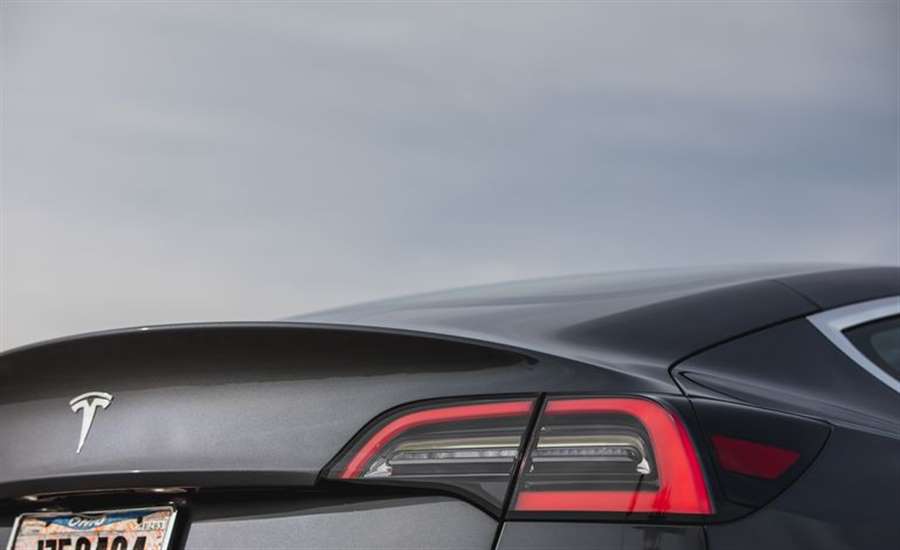
Then, on Christmas Day, disaster struck. While parked in a driveway, a short in the rear power inverter triggered a pyrotechnic fuse, which prevented an even worse outcome. Following a tow-truck ride to the closest service center about an hour away, the entire rear-motor assembly was replaced. We received plenty of emails and DMs from other Model 3 owners sharing similar stories of getting stranded at the hands of a Model 3. But we've had zero reliability issues since, related either to this event or anything else.
How Much Does Climate Control Affect EV Range?
Complaints about the automatic wipers have continued despite an update meant to improve them. Given the poor performance we've experienced, we question Tesla's choice to rely on the front cameras to control their operation rather than a rain sensor like every other automaker employs. Print director Eric Tingwall elaborates: "The wipers often lay dormant as the windshield becomes nearly opaque with spray from surrounding traffic. Then you wake them up by tapping the stalk for a single wipe, and they unnecessarily run at full speed for several minutes." Many also have commented on the difficulty in locating the wiper settings in the center screen.
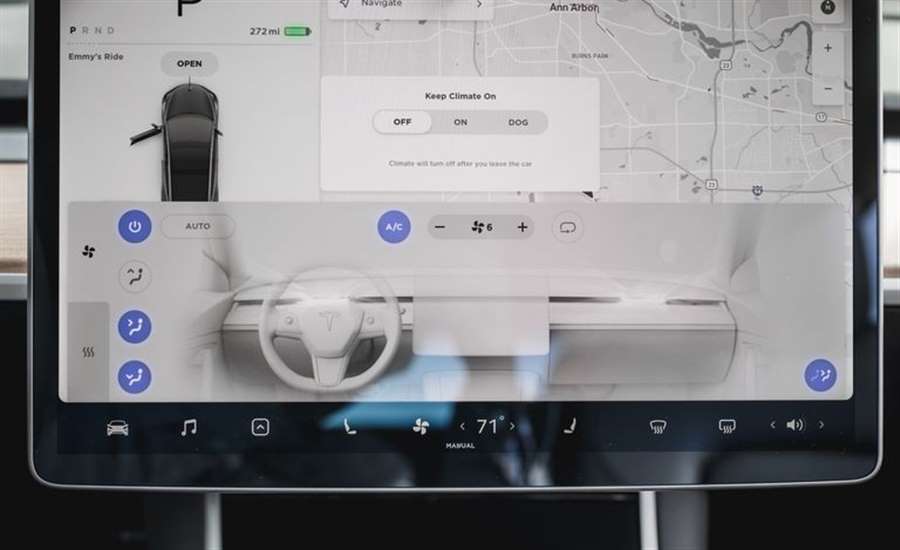
This brings us the most regular logbook refrain: the Model 3's near complete reliance on the center screen to control its various features and functions. "I now know how my grandma felt when we got her an iPad," said staff editor Connor Hoffman after driving our Model 3. "Every time I get in it, I find something new." Road-test editor Becca Hackett admitted to tinkering with the center screen for an hour in her garage as she tried to acclimate herself to the setup when she drove the car home for the first time. And staff editor Colin Beresford asks an existential question: "If a member of Gen Z can't find a feature on the screen, does it even exist?" Some of the few physical buttons that do remain are in odd locations, too, such as the hazard button up on the headliner. Other regular comments include the disconcertingly loud clunking noises that happen while plugged in at one of Tesla's fast-charging Superchargers. Although this doesn't happen in the Model S, it seems to be normal for the 3.
We've also done some experiments of our own. We discovered that the Model 3's plastic wheel covers improve range by up to 10 miles. And although the near-instant warm air blowing from the Tesla's HVAC system is welcome on a cold morning, we found that cranking up the climate control alone can reduce range by 60 miles. We also recently compared the charging speeds on one of Tesla's new 250-kW V3 Superchargers versus the older 150-kW units.
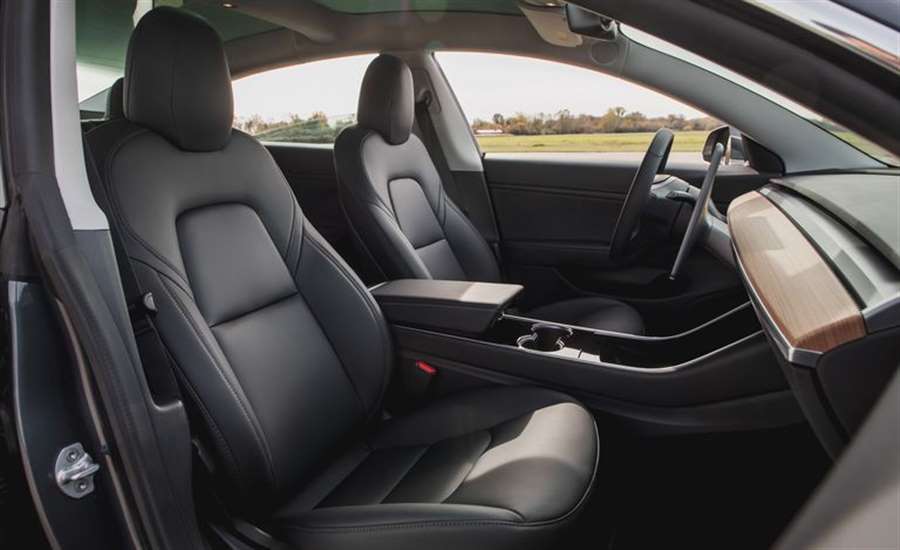
We're still waiting for substantial updates to the full self-driving option that added $6000 to the purchase price. Although Tesla has added more features to the visualization that appears on the left side of the screen while driving—including displaying traffic lights and construction cones—we're waiting for a real improvement in Autopilot's capability that Tesla has been teasing of late.
Not making it easy to keep up with the frequent updates is the fact that Tesla requires a Wi-Fi connection to download software and won't do so through the built-in data connection. Plus, the Model 3 only connects to simple Wi-Fi sources like the typical home router with a network name and password. Anything more complex, such as a network that requires a username and password, or if you need to open a browser window to agree to legal boilerplate, won't work.
So, where have we driven our Model 3? Not very far. We've mostly stayed in our home state of Michigan as we've soldiered through winter. Its logbook is full of anxiety-ridden comments about near misses on range, which we've been chewing through at a rate that's roughly 50 percent higher than predicted. Our farthest drive thus far was a 221-mile run from our office to northern Michigan. Longer road trips with multiple stops—such as Hoffman's recent 520-mile drive to St. Louis—generally don't allow attempts at range maximization since pit stops have to occur where the Superchargers are. And it's not time efficient to wait to recharge the battery all the way to 100 percent.
But we'll certainly be trying to improve upon that that as the winter tires come off, the temperatures continue to warm, and we're once again free to roam the country.
Months in Fleet: 6 months Current Mileage: 10,626 miles
Average Fuel Economy: 74 MPGe
Battery Capacity: 75.0 kWh Observed Fuel Range: 236 miles
Service: $0 Normal Wear: $0 Repair: $0
Damage and Destruction: $0
One of the most interesting things about the Model 3, and Teslas in general, is just how much it deviates from the norms of autodom. Unlike other automakers, which often wind up creating very similar entries by carefully tracking and matching features and equipment relative to the competition, it's refreshing—and occasionally annoying—how Tesla simply does its own thing.
As we're embarking on a 40,000-mile evaluation of a 2019 Model 3 Long Range, our second long-term Tesla after a 2015 Model S P85D, it's impossible not to notice this electric vehicle's vast differences compared with other compact-luxury sedans that exist at a similar size and price. There's no Apple CarPlay or Android Auto here, although the feature has become nearly ubiquitous among its luxury-sedan peers, nor even a gauge-cluster display in front of the driver. However, there are lots of wowing tricks up the Model 3's sleeve to win over people coming into contact with a Tesla for the first time, such as Emissions Testing mode, with six different fart-noise options, and Dog mode to keep our furry friends comfortable. And its phone-as-key feature works completely seamlessly, unlike more recent attempts by traditional automakers, such as Hyundai, that require awkwardly getting out a phone and holding it to the door handle. Plus, there's the very capable suite of Autopilot driver-assist features, which is now standard and generally works impressively to reduce the amount of steering, braking, and accelerating the driver needs to control.
Quick and Enjoyable
Especially when viewed from the front, we wouldn't call the Model 3 attractive, but the low cowl and large glass area make for an expansive forward view. And that is one of a flurry of positive comments about driving the Model 3; it's extremely quick, with direct steering and even a willingness of our all-wheel-drive model to rotate under power. We're suckers for its instant response and forceful acceleration—at 4.1 seconds to 60 mph, this latest 3 is 0.9 second quicker than the initial Model 3 Long Range we tested, which only had a rear motor, and it's also just 0.3 second off the pace of the swift BMW M340i. What's more, the Tesla's power delivery sets itself apart by its instantaneousness, which is demonstrated by our 5-to-60-mph rolling-start test. The Model 3 nails it in 4.2 seconds, whereas today's highly boosted gas engines often have a significant gap between their standing-start and rolling-start metrics (the difference on the M340i, for example, is 0.9 second).
The Model 3 stacks up less well in other areas against the usual luxury players—BMW 3-series, Audi A4, Mercedes C-class—where its plasticky seat material, fixed and narrow headrests, and ultracheap, cardboard-like cover for the large bin under the trunk floor don't live up to its luxury price point. The Model 3 also isn't as hushed over the road as the traditional players; there's a lot of wind noise at 70 mph, and at 70 decibels, it measures one to two decibels louder at that speed than the segment norms. And that's not including the way it clomps loudly over lateral pavement seams, which is partly a result of its high, 42-psi tire pressures that help manage the Model 3's 4038-pound curb weight (that's 141 pounds heavier than the rear-drive Model 3 we tested in 2018) and boost its range.
Among the oft-discussed issues on early Model 3s were panel gaps and overall build quality, and in that area, this latest car is far better than our earlier example. However, the hood wasn't quite level on our car when it arrived, so we adjusted the hood grommets to make it so. We're already noticing some squeaks and rattles emanating from the instrument panel, particularly in the cold weather that has descended on our Michigan HQ.
Data Tracking
We're using third-party software called TeslaFi to corral a staggering amount of data streaming from our car, including its whereabouts, mileage, charging and charge efficiency, temperatures outside and inside the vehicle, and climate-control usage. In our first two months, we've spent 85.5 hours behind the wheel of our Model 3 over 280 drives and a total of 3867 miles. However, partly due to an average outside temperature of 43 degrees, we've used nearly 50 percent more rated range than miles actually driven. That has led to complaints that the main range readout does not adjust downward when using up the battery at a quicker rate than its EPA rating suggests. However, there is a running average figure based on recent driving, found on the Energy screen. We've also noted that the battery's state of charge can drop by 5 percent or so when the Model 3 sits outside overnight in 40-degree temperatures without being plugged in.
Tesla Smart Summon Feature Is Looking Reckless
The only options on our test car are its $1000 Midnight Silver Metallic paint and the $6000 Full Self-Driving Capability, bringing our total sticker price to $57,690. While the latter feature—currently priced at $7000—promises at some point in the future to actually fulfill its name, for now it enables advanced Autopilot moves such as Smart Summon, where the Model 3 will drive itself to the location of the owner's smartphone in a parking lot, and automatic lane changes around slower traffic on the highway. Our car has the base 18-inch wheels with all-season tires and the aero wheel covers, and we tested just how much slipperier those covers are through the passing air than the better-looking aluminum wheels hiding beneath.
What has become a Tesla trademark is continual upgrades, and in the two short months we've had our car, we've downloaded Version 10 software, which added Smart Summon, and built-in Netflix, YouTube, Hulu, and Spotify streaming. Very recently, we updated to 10.1, which promises a 5 percent bump in horsepower. We'll be headed back to the test track to see how much that improves the already very quick acceleration numbers. No doubt there will be lots to talk about.
Source: caranddriver.com
2021 Hyundai Elantra Review: Almost Great
The redesigned 2021 Hyundai Elantra compact sedan would be excellent rather than good if not for its lackluster cabin materials. If developing a car was a marathon, Hyundai didn’t run the last mile.
Versus the competition: For a mass-market compact sedan, the Elantra combines class-leading drivability with loads of user-friendly technology. Alas, its low-rent interior weighs all that down.
For 2021, the Hyundai Elantra sedan comes in SE, SEL and Limited trim levels, all with a 2.0-liter four-cylinder engine. (The Elantra GT hatchback has been discontinued.) The first-ever Elantra Hybrid, meanwhile, pairs a smaller four-cylinder with electric assist; it comes in SEL and Limited trims. Finally, the Elantra N Line has a turbocharged four-cylinder and the lineup’s only manual transmission. (Note that a higher-performance Elantra, called simply the N, without the “Line,” remains in the works as of this writing.) All other variants have an automatic, which is also available on the N Line. Stack up the whole current group, or compare the 2020 and 2021 Elantra.
We evaluated an SEL over the course of a week and also took brief drives in the Limited Hybrid and a stick-shift N Line.
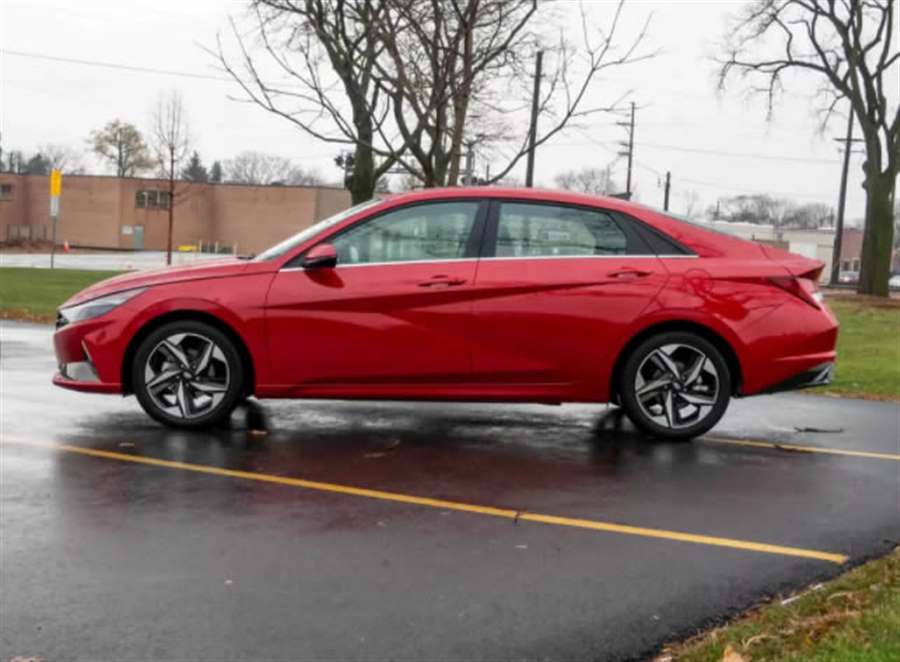
SE, SEL, Limited: Refined Drivability
A confounding but age-old reality in our recent comparison between the Honda Civic, Nissan Sentra and Toyota Corolla sedans was the trade-off between ride quality and handling chops. Hyundai elevates both better than any car in that trio, as well as most other compact sedans.
Despite a torsion-beam rear axle — a cost-saving setup versus the independent rear suspensions used by some rivals, including the Civic and Corolla — the Elantra rides impressively. Aside from some skittishness during mid-corner bumps, body control feels impressive for a mass-market compact sedan. Ditto for shock absorption: The suspension takes sewer covers and rutted pavement with a degree of sophistication reminiscent of a larger, or pricier, car — and that’s with our SEL model’s optional 17-inch wheels and P225/45R17 tires. With available wheel diameters ranging from 15 to 18 inches, it’s possible lesser versions of the Elantra ride even more comfortably. (All other things being equal, larger wheels generally diminish ride quality.)
Kudos, too, for the Elantra’s reflexes. Fling it into a corner and the nose pushes early, but the steering feels as quick-ratio as the Civic’s — still one of the best-handling cars in the class — with less of the outgoing Elantra’s vagueness. The wheel seldom feels twitchy on center even at higher speeds, and body roll is nicely contained through sweeping curves.
Under the hood is last year’s 2.0-liter four-cylinder engine (147 horsepower, 132 pounds-feet of torque), which runs on a more-efficient Atkinson cycle; gone is the prior generation’s Eco trim and its turbocharged 1.4-liter four-cylinder. The 2.0-liter has reasonable power past 3,000 rpm or so, and Hyundai’s continuously variable automatic transmission is a motivated partner to get you there. Revs climb energetically from a stop, and if you need more power while already in motion, the CVT kicks up engine rpm swiftly enough to mimic a downshift from a conventional automatic. The 2021 Elantra is not particularly quick, but it does a nice job with what it has to offer.
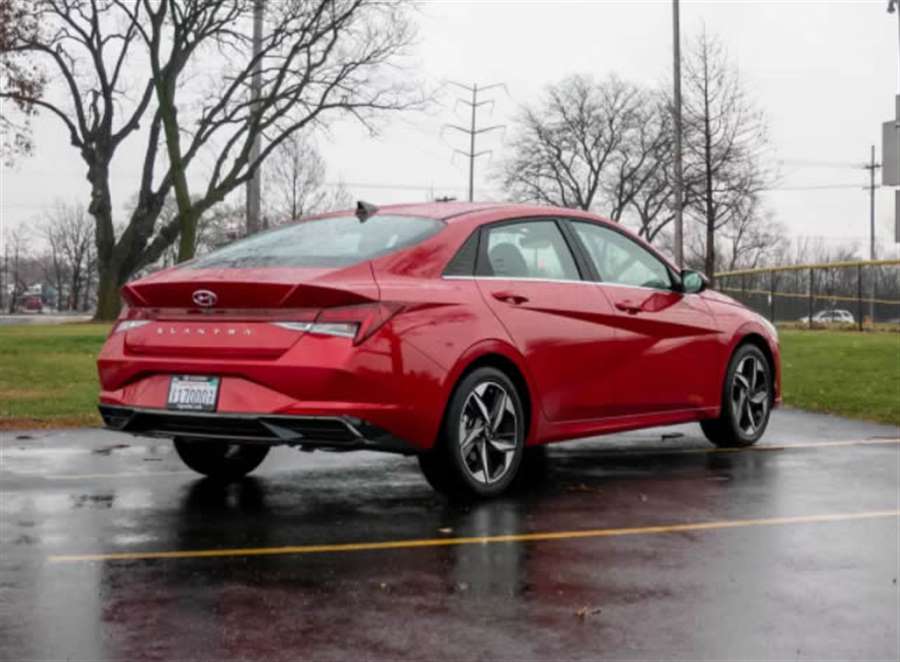
Elantra Hybrid: Even Better
The Elantra Hybrid pairs a 1.6-liter Atkinson four-cylinder with a 32-kilowatt electric motor for a total system output of 139 hp and 195 pounds-feet of torque. It’s a handy combination, particularly on the torque side, to move you out from a stop. Unlike the many hybrids that employ CVT-like power-split devices, Hyundai’s system uses a conventional stepped automatic transmission — in this case a six-speed dual-clutch unit. The stepped gears bring a welcome sensation of upshifts and downshifts, though the downshifts arrive only after a long delay or hard stab on the gas. Sport mode provides much-needed accelerator responsiveness — there’s your downshift — if you don’t mind sacrificing fuel efficiency.
That efficiency is considerable, with 50 mpg in EPA-estimated combined gas mileage (54 mpg in a higher-efficiency Elantra Hybrid Blue edition). That’s up some 40% over the Elantra’s still-impressive EPA 35 mpg combined (37 mpg for the SE trim). Both figures are competitive against respective rivals; compare Elantra Hybrid mileage or the regular Elantra’s.
The Elantra Hybrid gets an independent rear suspension versus the non-hybrid’s torsion beam, but the differences are hard to pick out. I drove the Elantra Hybrid Limited back to back with an Elantra SEL, both with 17-inch wheels, over the same route. Both cars rode similarly well — more of a feat for the SEL’s simpler hardware, perhaps, but we preach results over formula. The results speak for themselves.
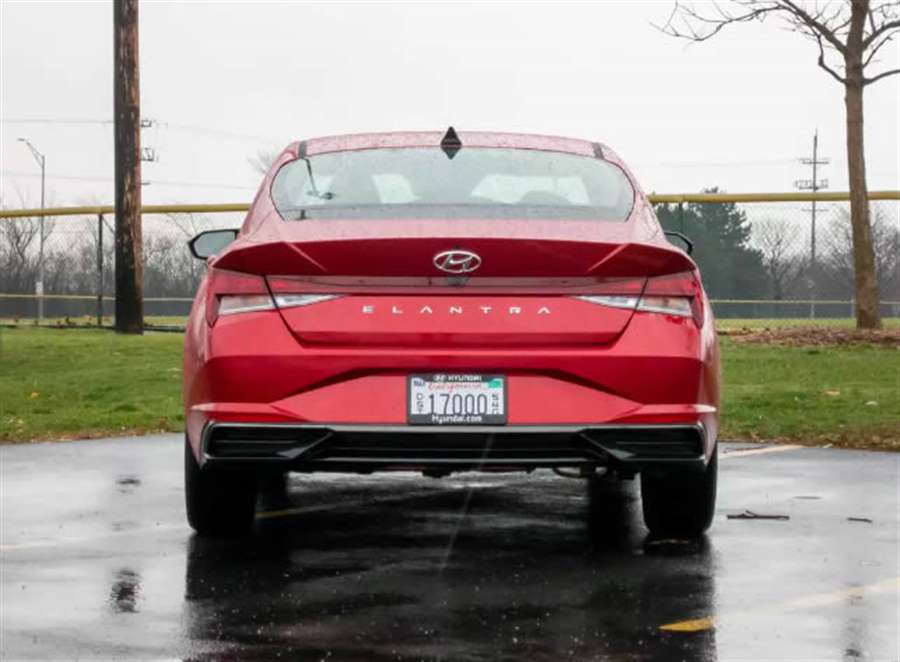
Elantra N Line: A Minor Letdown
If there’s any disappointment in how the Elantra drives, it comes with the N Line. Like the Elantra Hybrid, it gets an independent rear suspension, but tuning is stiffer all around versus the regular Elantra, with a thicker front stabilizer bar, as well. It shows: Shock absorption is notably firmer — though not objectionably so, as was the case with its Elantra Sport predecessor. The steering, altered here for N Line duty, augments the regular Elantra’s quick ratio with better feedback. Whether through chassis tuning or better grip (our test car had Goodyear Eagle F1 summer tires), or a little of both, understeer feels immediately better contained.
So where’s the letdown? It’s all in the N Line’s powertrain. The N Line packs Hyundai’s turbocharged 1.6-liter four-cylinder (201 hp, 195 pounds-feet of torque), an engine we’ve seldom found responsive enough. Hyundai says peak torque comes as early as 1,500 rpm, but it’s only after notable turbo lag. The lag diminishes if you keep engine revs north of 4,000 rpm or so, which requires frequent work with the stick-shift N Line’s longish throws and muddy gates. Even then, the N Line never feels particularly quick. The optional automatic transmission is a seven-speed dual-clutch unit, so it might alter some of the power delivery. Alas, we didn’t evaluate it.
Tech Features
SE, SEL and N Line models have two USB ports, HD radio and an 8-inch touchscreen with adjacent physical controls, including the must-have volume and tuning knobs. Impressively, the standard Apple CarPlay and Android Auto both have wireless integration. Wireless phone charging — critical if you really want to go cord-free, as wireless Apple CarPlay and Android Auto can drain your phone’s battery fast — is optional, as are all-digital gauges.
The Limited trim comes with wireless charging and swaps the 8-inch screen for a 10.25-inch touchscreen. It’s a slick, high-resolution display, but it introduces some annoyances. Gone is the tuning knob, and both Apple CarPlay and Android Auto revert to a wired setup. What’s more, the larger display has a widescreen ratio that’s starved for height, so items like the backup camera image appear only on part of the screen. The navigation map and Apple CarPlay leverage the entire display, but I didn’t test Android Auto (I’m an iPhone user). Cars.com staffers with Android devices have observed display limitations in other Hyundai models with the automaker’s 10.25-inch display. See for yourself on a test drive.
The Fatal Flaw?
For all the Elantra’s strengths, the obvious flaw comes inside. It’s not space: The low center console affords a wide berth for the driver, and backseat knee clearance should suit adult passengers. Our independent accounting of cargo space found 19 cubic feet in the Elantra’s trunk, within 1 cubic foot of our accounting in the Civic, Corolla and Sentra.
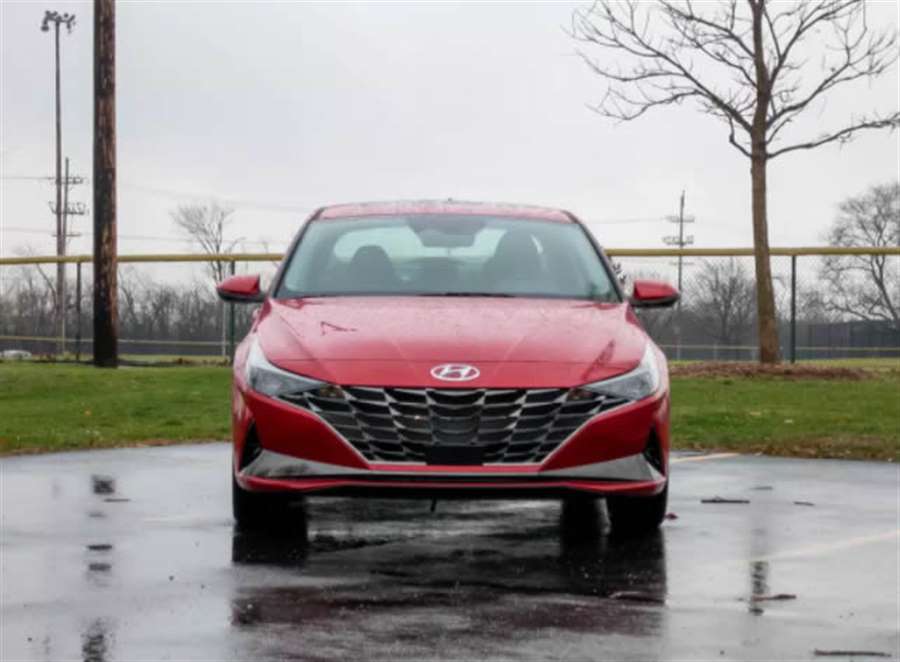
Hyundai’s problem is materials quality. Even in the Limited trim, the upper doors, where your arms and elbows might rest, are all cheap hard plastic, as are most areas your knees touch. Things decline even further in the backseat, where the dollar-store treatment extends to the door armrests. The glove box opens with an undamped clatter; the headliner is mouse fur.
All of that falls in line with the prior-generation Elantra, no standout for cabin materials itself. But if you haven’t been in other compact cars, you’re missing out. The Civic and Impreza have a proper woven headliner. The Sentra offers soft-touch materials where your knees land, and almost all rivals have soft-touch door materials up front, especially in higher trim levels. The Mazda3 keeps it classy front and rear.
There’s potential to right the ship immediately. All major controls feel uniformly meticulous, unlike rivals like the Corolla. All Hyundai would have to do is swap in better materials immediately for a modest cost per car. Of course, the bean counters will multiply that by the hundreds of thousands of cars the automaker hopes to sell. You know how that ends.
Features and Value
As of this writing, the Insurance Institute for Highway Safety has yet to publish crash-test results for the 2021 Elantra, but once the agency does, those results will appear here. Standard safety and driver-assist features include automatic emergency braking with pedestrian detection, a blind spot warning system and lane-centering steering.
The Elantra SE starts just under $21,000 (all prices include destination). That’s roughly competitive with rivals’ base models, most of which have standard automatic transmissions, as well. Standard features include 15-inch alloy wheels, the 8-inch touchscreen with wireless phone integration and the aforementioned safety tech. Finding an SE might be hard, however: As of this writing, just 12% of new 2021 Elantra sedans on Cars.com are SE models, and that’s with the Elantra Hybrid and N Line not yet on sale. Their eventual arrival will consign the SE to an even smaller slice of the pie.
The vast majority of current inventory is the next-up Elantra SEL (about $22,000), which adds larger wheels, dual-zone automatic climate control and keyless access with push-button start. Add options or climb the trim levels, and you can get leather upholstery, a power driver’s seat with memory, heated and ventilated front seats, the larger touchscreen, Bose premium audio, adaptive cruise control and Highway Driving Assist. (HDA augments Hyundai’s standard lane-centering, called Lane Following Assist, with additional capabilities on designated highways. Read more about the differences.)
The N Line runs about $25,000, while the well-equipped Limited (around $26,500) doesn’t have any factory options. The Elantra Hybrid, meanwhile, exacts a $2,650 premium for its SEL and Limited trims versus the same non-hybrid examples. As such, expect an Elantra Hybrid Limited to set you back about $29,000 — likely the highest sticker price most shoppers will see on any Elantra. That’s still a decent value, especially considering Hyundai’s impressive warranty and three years’ free maintenance.
Value might drive many shoppers toward the Elantra, and excellent drivability should justify consideration even among the less budget-conscious. The downfall comes with Hyundai’s lack of investment inside, a peskiness that leaves the Elantra at four-fifths of great.
Source: cars.com
2021 Mazda Mazda6
The 2021 Mazda6’s engaging ride and high-end cabin help it land in the top third of our midsize car rankings.
Is the Mazda6 a Good Car?
Yes, the Mazda6 is a good midsize car. It boasts adept handling, responsive steering, and two peppy four-cylinder engine options. It also has an upscale cabin and comes with an abundance of safety tech and infotainment features, including newly standard Android Auto and Apple CarPlay capability. Rear-seat legroom is slightly cramped, and its infotainment system isn't as user-friendly as those of rivals, but those are this Mazda's only major negatives.
Why You Can Trust Us: 56 Reviews Analyzed
We’ve analyzed 56 Mazda6 reviews, as well as performance specs, interior dimensions, fuel economy ratings, and more, to give you all the information you need to make a smart car-buying decision.
This 2021 Mazda6 review incorporates applicable research for all models in this generation, which launched for 2014.
U.S. News Best Cars has been ranking and reviewing vehicles since 2007, and our staff has more than 75 years of combined experience in the auto industry. To ensure our objectivity, we never accept expensive gifts from carmakers, and an outside firm manages the ads on our site.
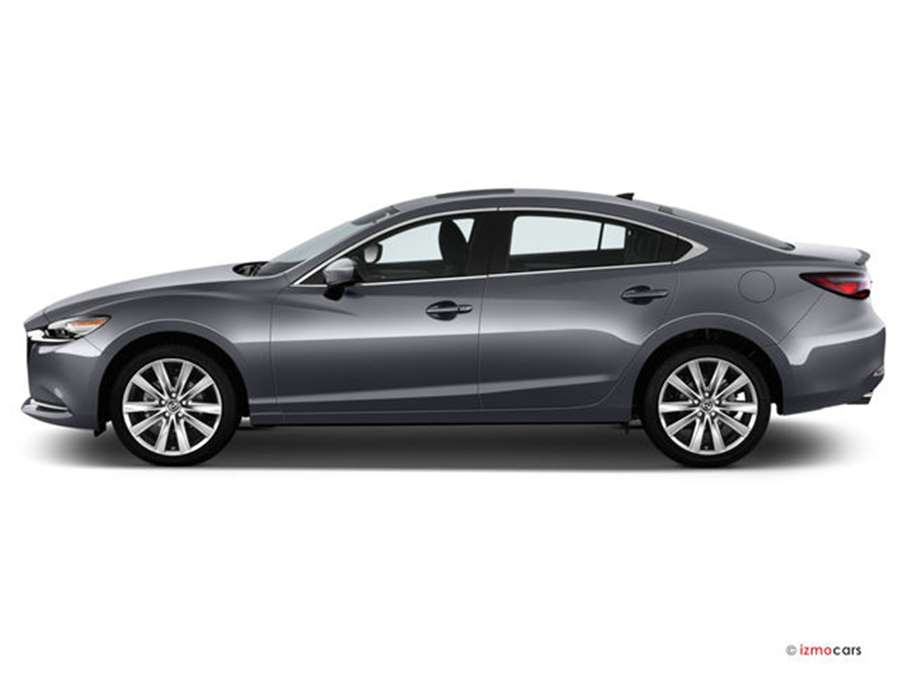
Should I Buy the Mazda6?
If you’re looking for a fun-to-drive midsize car, it’s hard to beat the Mazda6. That said, there are a few other vehicles worth considering before you make your purchase decision. The Toyota Camry is nearly as fun to drive as the Mazda, and it's available with a very strong V6 engine option. The Honda Accord isn't as athletic as the Mazda, but it offers more passenger space and additional cargo room.
2020 vs. 2021 Mazda6: What's the Difference?
For the 2021 model year, the Mazda6 gains standard Android Auto and Apple CarPlay, while wireless Apple CarPlay is newly available. Additionally, Mazda debuts a new Carbon Edition trim.
Here are the key changes for the Mazda6 over the last few years:
2017: upgraded infotainment system; Bluetooth and a rearview camera became standard; blind spot monitoring and rear cross traffic alert became standard in 2017.5 models
2018: refreshed interior styling; gained an available turbocharged engine and available Apple CarPlay and Android Auto
2019: gained some standard safety features; six-speed manual transmission discontinued
2020: no major changes
2021: Apple CarPlay and Android Auto added to standard features list; Carbon Edition trim introduced
If you're considering an older model, be sure to read our 2018 Mazda6, 2019 Mazda6, and 2020 Mazda6 reviews to help make your decision. Also, check out our Best New Car Deals and Best New Car Lease Deals pages to learn about savings and discounts you can find on new vehicles.
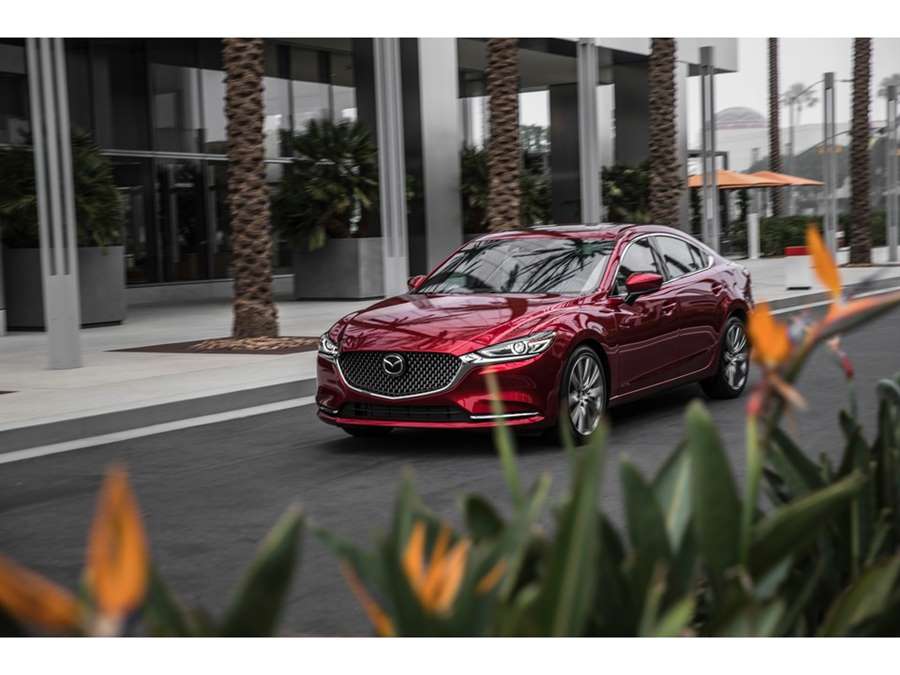
How Much Does the Mazda6 Cost?
The 2021 Mazda6 starts at $24,325, which is roughly average for a midsize car. The top-of-the-line Signature trim has a starting price of $35,750.
Check out our U.S. News Best Price Program for great savings at your local Mazda dealer. You can also find excellent manufacturer incentives on our Mazda deals page.
How Much Does It Cost to Insure a Mazda Mazda6?
The cost of insuring a Mazda Mazda6 will depend on a variety of factors, including your deductible, the level of coverage that you want, and the type of insurance that you choose. Your age, gender, location, credit score, and driving record can also have an impact on your insurance rates. Check out our car insurance guide to find the best policy for you.
Mazda6 vs. Toyota Camry
The Toyota Camry is just as enjoyable to drive as the Mazda6. The Toyota has plenty of power in its base four-cylinder engine, and its optional V6 engine is stronger than any of the Mazda's offerings. Additionally, the Camry has an easier-to-use infotainment system, a more spacious second row, a higher predicted reliability rating, and better gas mileage estimates. The Mazda6 is a good car, but the Camry is even better.
Mazda6 vs. Honda Accord
The Honda Accord and Mazda6 are neck and neck in our midsize car rankings, and choosing between them will come down to personal preference. The Mazda has more athletic handling, but the Honda offers two turbocharged four-cylinder engine options, and it delivers a gentle ride with lively handling. You’ll also get more passenger room and cargo space with the Honda. Ultimately, these are both solid picks; you can't go wrong with either.
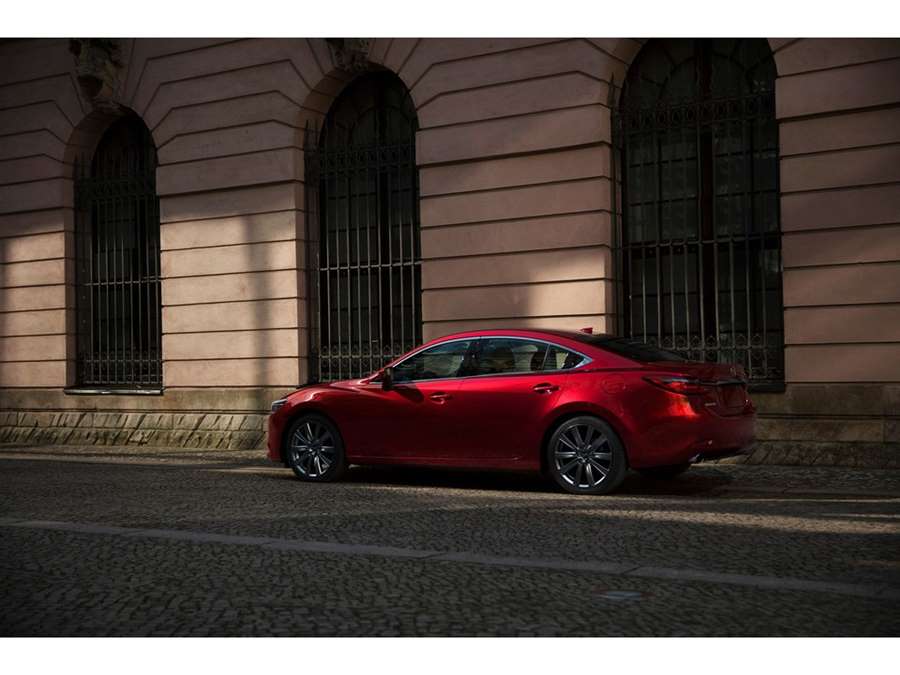
Mazda6 Cargo Space
This Mazda has a 14.7-cubic-foot trunk that provides enough room to store over a dozen grocery bags. The trunk is small for the class, however, and the release handles that fold down the back seats can only be accessed from the trunk. On the plus side, the 6 comes standard with 60/40-split-folding rear seats.
How Many People Does the Mazda6 Seat?
The Mazda6 seats up to five people. The front seats are well contoured, and there's adult-friendly seating throughout the cabin. However, some critics note that the car could benefit from extra rear-seat legroom.
Mazda6 and Child Car Seats
There are two complete sets of LATCH connectors for the rear outboard seats and a tether anchor for the rear middle seat. The middle seat can also borrow lower anchors from the adjoining seats. The Insurance Institute for Highway Safety gave this system the highest rating of Good+, which indicates that it's among the easiest to use.
Mazda6 Interior Quality
This Mazda has one of the nicest cabins in the midsize car class. Some reviewers say its upscale interior materials are close to what you would find in a luxury vehicle. Some optional comfort features include synthetic leather upholstery, genuine leather upholstery, ventilated front seats, and heated front seats.
Mazda6 Infotainment, Bluetooth, and Navigation
The Mazda Connect infotainment system comes standard in the Mazda6. This system features a touch screen, but its lockout feature prevents you from using touch controls while driving. Instead, drivers must use the central control knob when the car is in motion. Most critics praise the control knob as easy to use, but some complain that there are too many menus to wade through to get to certain functions.
Standard infotainment features: an 8-inch touch screen, six speakers, Android Auto, Apple CarPlay, HD Radio, Bluetooth, voice recognition, and two front USB ports
Available infotainment features: rear USB ports, satellite radio, wireless Apple CarPlay, an 11-speaker premium Bose stereo, and navigation
Additional standard features: push-button start, remote keyless entry, and dual-zone automatic climate control
Other available features: proximity keyless entry and a moonroof

Mazda6 Engine
A 187-horsepower 2.5-liter four-cylinder engine is standard in the Mazda6. A turbocharged four-cylinder that produces 227 or 250 horsepower (depending on the grade of gasoline you pump into the tank) comes standard in Grand Touring trims and up. Both engines are paired to a six-speed automatic transmission that delivers smooth shifts. The base engine is powerful and helps the vehicle accelerate quickly, but the upgraded engine offers significantly more pep.
Mazda6 Gas Mileage
The 2021 Mazda6 gets 26 mpg in the city and 35 mpg on the highway in its standard setup, which is about average for the midsize car class. Models with the upgraded engine get an EPA-estimated 23 mpg in the city and 31 mpg on the highway.
Mazda6 Ride and Handling
The Mazda6’s responsive steering and athletic handling help make it a thrill to drive, without sacrificing ride comfort. Front-wheel drive is standard. All-wheel drive is not available.
Is the Mazda6 Reliable?
The 2021 Mazda6 has a predicted reliability rating of three out of five, which is about average.
Mazda6 Warranty
Mazda covers the 2021 Mazda6 with a three-year/36,000-mile basic warranty and a five-year/60,000-mile powertrain warranty.
Mazda6 Crash Test Results
The National Highway Traffic Safety Administration gave the 2021 Mazda6 an overall safety rating of five out of five stars, with five stars in the frontal and side crash tests and four stars in the rollover test.
The Insurance Institute for Highway Safety named the 2021 Mazda6 a Top Safety Pick+, giving it the highest rating of Good in all six crash tests and the second-highest rating of Acceptable for how well its headlights illuminate the road ahead. Models with adaptive headlights earned the highest rating of Good.
The IIHS uses a different scale for grading collision avoidance features. It gave this car the highest rating of Superior for its standard vehicle-to-vehicle front crash prevention system, as well as the second-highest rating of Advanced for its standard vehicle-to-pedestrian system.
Mazda6 Safety Features
Standard advanced safety features:
Automatic high-beam headlights
Rain-sensing windshield wipers
Lane departure warning
Lane keep assist
Forward collision warning
Forward automatic emergency braking
Pedestrian detection
Adaptive cruise control
Blind spot monitoring
Rear cross traffic alert
Rearview camera
Available advanced safety features:
Head-up display
Front and rear parking sensors
Reverse automatic emergency braking
360-degree parking camera system
Traffic sign recognition
Driver attention alert
Adaptive headlights
Mazda6 Dimensions and Weight
The Mazda6 is about 16 feet long. Its curb weight ranges from 3,437 to 3,582 pounds, and its gross vehicle weight rating is between 4,473 and 4,552 pounds.
Where Is the 2021 Mazda6 Built?
Mazda builds the 2021 Mazda6 in Japan.
Which Mazda6 Model Is Right for Me?
The 2021 Mazda6 comes in six trims: Sport, Touring, Grand Touring, Grand Touring Reserve, Carbon Edition, and Signature. The base Sport trim is filled with infotainment, safety, and comfort features, which make it a great pick for most shoppers. The Sport and Touring trims come with the base four-cylinder engine, while every other trim gets the upgraded turbocharged engine.
Mazda6 Sport
The Sport trim (MSRP: $24,325) comes with an 8-inch touch screen, six speakers, Android Auto, Apple CarPlay, HD Radio, Bluetooth, voice recognition, and two front USB ports. Other standard features include push-button start, remote keyless entry, dual-zone automatic climate control, a leather-wrapped steering wheel and shift knob, cloth upholstery, and six-way manually adjustable front seats.
A host of active safety features are also standard, including lane departure warning, lane keep assist, forward collision warning, forward automatic emergency braking, pedestrian detection, adaptive cruise control, blind spot monitoring, rear cross traffic alert, automatic high-beam headlights, rain-sensing windshield wipers, and a rearview camera.
Mazda6 Touring
Starting at $26,925, the Touring trim gains rear USB ports, synthetic leather upholstery, heated front seats, a six-way power-adjustable driver's seat, proximity keyless entry, and a moonroof.
Mazda6 Grand Touring
The Grand Touring trim starts at $30,025. In addition to the turbocharged engine, the Grand Touring adds satellite radio, and an 11-speaker premium Bose stereo.
Mazda6 Grand Touring Reserve
The Grand Touring Reserve trim starts at $32,525 and gains wireless Apple CarPlay, adaptive headlights, genuine leather upholstery, ventilated front seats, an eight-way power-adjustable driver's seat, a six-way power-adjustable passenger seat, a heated steering wheel, and a head-up display.
Mazda6 Carbon Edition
The Carbon Edition trim (MSRP: $32,800) adds red leather upholstery, red and black interior accents, and gloss black exterior accents.
Mazda6 Signature
The top-of-the-line Signature trim has a starting price of $35,750. It gains ambient lighting, Nappa leather upholstery, navigation, traffic sign recognition, a 360-degree parking camera system, front and rear parking sensors, and driver attention alert.
Source: cars.usnews.com

